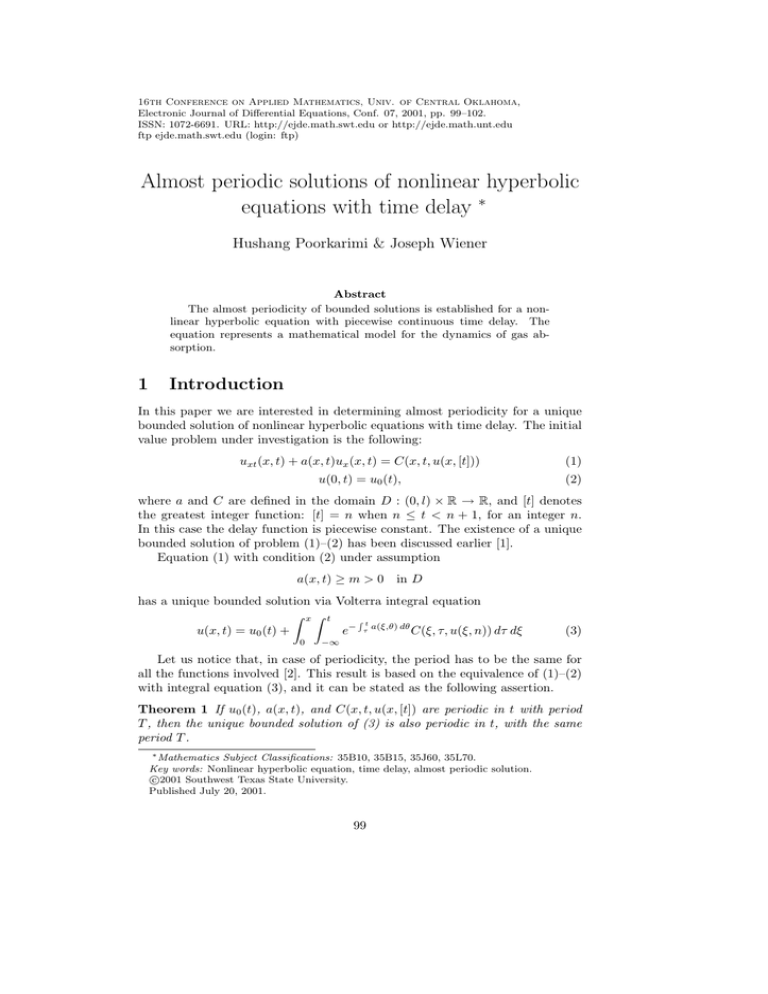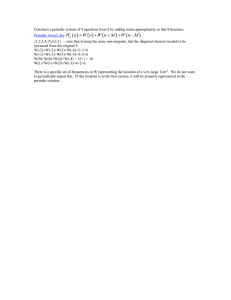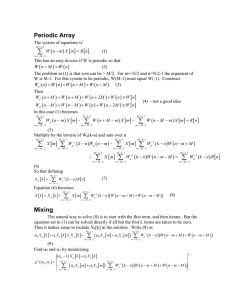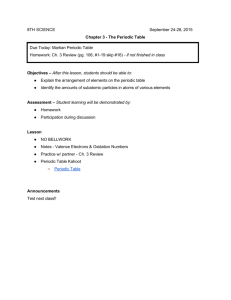Document 10773383
advertisement

16th Conference on Applied Mathematics, Univ. of Central Oklahoma, Electronic Journal of Differential Equations, Conf. 07, 2001, pp. 99–102. ISSN: 1072-6691. URL: http://ejde.math.swt.edu or http://ejde.math.unt.edu ftp ejde.math.swt.edu (login: ftp) Almost periodic solutions of nonlinear hyperbolic equations with time delay ∗ Hushang Poorkarimi & Joseph Wiener Abstract The almost periodicity of bounded solutions is established for a nonlinear hyperbolic equation with piecewise continuous time delay. The equation represents a mathematical model for the dynamics of gas absorption. 1 Introduction In this paper we are interested in determining almost periodicity for a unique bounded solution of nonlinear hyperbolic equations with time delay. The initial value problem under investigation is the following: uxt (x, t) + a(x, t)ux (x, t) = C(x, t, u(x, [t])) u(0, t) = u0 (t), (1) (2) where a and C are defined in the domain D : (0, l) × R → R, and [t] denotes the greatest integer function: [t] = n when n ≤ t < n + 1, for an integer n. In this case the delay function is piecewise constant. The existence of a unique bounded solution of problem (1)–(2) has been discussed earlier [1]. Equation (1) with condition (2) under assumption a(x, t) ≥ m > 0 in D has a unique bounded solution via Volterra integral equation Z xZ t Rt u(x, t) = u0 (t) + e− τ a(ξ,θ) dθ C(ξ, τ, u(ξ, n)) dτ dξ 0 (3) −∞ Let us notice that, in case of periodicity, the period has to be the same for all the functions involved [2]. This result is based on the equivalence of (1)–(2) with integral equation (3), and it can be stated as the following assertion. Theorem 1 If u0 (t), a(x, t), and C(x, t, u(x, [t]) are periodic in t with period T , then the unique bounded solution of (3) is also periodic in t, with the same period T . ∗ Mathematics Subject Classifications: 35B10, 35B15, 35J60, 35L70. Key words: Nonlinear hyperbolic equation, time delay, almost periodic solution. c 2001 Southwest Texas State University. Published July 20, 2001. 99 100 Almost periodic solutions Proof From (3), one obtains u(x, t + T ) = u0 (t + T ) + x Z Z t+T e− R t+T τ a(ξ,θ) dθ C(ξ, τ, u(ξ, n)) dτ dξ. −∞ 0 Making the substitution τ = η + T and taking into account Z t+T a(ξ, θ) dθ = η+T η Z a(ξ, θ) dθ + η+T Z t a(ξ, θ) dθ + Z η t+T a(ξ, θ) dθ t we have u(x, t + T ) = u0 (t) + Z x Z 0 t e− Rt η a(ξ,θ) dθ C(ξ, η, u(ξ, n)) dηdξ = u(x, t) −∞ which proves the periodicity of u in t with period T . Definition 2 (Bohr’s Definition of –almost periodicity) For any > 0, there exists a number l() > 0 with property that any interval of length l() of the real line contains at least one point with abscissa δ, such that |u(x, t + δ) − u(x, t)| < , (x, t) ∈ D , the number δ is called translation number of u(x, t) corresponding to , or an -almost period of u(x, t). The following lemma will be used to prove that the unique bounded solution (in D) of equation (3) is almost periodic in t. Lemma 3 Assume the following conditions hold true in regard to the equation Vt (x, t) + a(x, t)V (x, t) = f (x, t), in D : (0, l) × R → R (4) 1. a(x, t), f (x, t) are almost periodic in t, uniformly with respect to x; 2. a(x, t) ≥ m > 0 in D. Then the unique bounded solution of (4), given by V (x, t) = Z t e− Rt τ a(x,θ) dθ f (x, τ ) dτ, (5) −∞ is almost periodic in t, uniformly with respect to x, and |V (x, t)| ≤ 1 sup |f (x, t)| , m (x, t) ∈ D. (6) Hushang Poorkarimi & Joseph Wiener 101 Proof We obtain from (4), changing t to t + δ: Vt (x, t + δ) + a(x, t + δ)V (x, t + δ) = f (x, t + δ), and subtracting (4) from it, [V (x, t + δ) − V (x, t)]t + a(x, t + δ) [V (x, t + δ) − V (x, t)] = f (x, t + δ) − f (x, t) − [a(x, t + δ) − a(x, t)] V (x, t). Taking into account the almost periodicity of a(x, t), f (x, t) and boundedness of V (x, t) in D, one obtains in D, according to (6): sup |V (x, t + δ) − V (x, t)| ≤ 1 sup |f (x, t + δ) − f (x, t)| m M + sup |a(x, t + δ) − a(x, t)| , m where M = sup |V (x, t)|, (x, t) ∈ D. We choose δ such that, |f (x, t + δ) − f (x, t)| < m , 2 and |a(x, t + δ) − a(x, t)| < m 2M for sufficiently large t, i.e., f (x, t) must be an (m)/2-almost periodic and a(x, t) is (m)/2M -almost periodic. Then sup |V (x, t + δ) − V (x, t)| ≤ + = for all such δ ∈ R. 2 2 (7) In other words, for any > 0, there exists a number l() > 0 with the property that any interval (a, a + l) ∈ R contains an -almost period of V (x, t). This means that V (x, t) is an almost periodic function in t, uniformly with respect to x ∈ [0, l] by Bohr’s definition of almost periodicity. Let us conclude now with the result on almost periodicity of the unique bounded solution of (3) in D. Theorem 4 Consider equation (1) in D, and assume u0 (t), a(x, t), and C(x, t, u(x, [t])) are almost periodic in t, uniformly with respect to x ∈ [0, l], and a(x, t) ≥ m > 0. Also assume that C(x, t, u(x, [t])) is continuous on D × R, with C(x, t, 0) bounded on D, and satisfies the Lipschitz condition |C(x, t, u(x, [t])) − C(x, t, V (x, [t]))| ≤ L |u(x, [t]) − V (x, [t])| where L is a positive constant. Then the unique bounded solution of (1)–(2) in D is almost periodic in t, uniformly with respect to x ∈ [0, l]. Proof Let the first approximation be u0 (x, t) ≡ 0. Next approximation is then Z xZ t Rt u1 (x, t) = u0 (t) + e− τ a(ξ,θ) dθ C(ξ, τ, 0) dτ dξ . 0 Since V (x, t) = ∂ ∂x u1 (x, t), −∞ then from the equation Vt (x, t) + a(x, t)V (x, t) = C(x, t, 0) 102 Almost periodic solutions by Lemma 2 we obtain the almost periodicity of V (x, t). But Z x u1 (x, t) = u0 (t) + V (ξ, t) dξ. 0 This shows that u1 (x, t) is almost periodic in t, uniformly with respect to x ∈ [0, l], and u2 (x, t) = u0 (t) + Z 0 The relation V (x, t) = x Z t e− Rt τ a(ξ,θ) dθ C(ξ, τ, u1 (ξ, τ )) dτ dξ. −∞ ∂ ∂x u2 (x, t) and equation Vt (x, t) + a(x, t)V (x, t) = C(x, t, u1 (x, t)) implies almost periodicity of u2 (x, t) = u0 (t) + Z x V (ξ, t) dξ, 0 by Lemma 2. Then u3 (x, t) is almost periodic by a similar argument. Consequently, all successive approximations un (x, t), n = 1, 2, . . . are almost periodic functions in t, uniformly with respect to x ∈ [0, l]. Hence the solution u(x, t) = lim un (x, t) n→∞ is also almost periodic in t, uniformly with respect to x ∈ [0, l]. References [1] Poorkarimi, H., and Wiener, J., (1986), “Bounded Solutions of Non-linear Hyperbolic Equations with Delay”, Proceedings of the VII International Conference on Non-Linear Analysis, V. Lakshmikantham, Ed., 471–478 [2] Poorkarimi, H., “Asymptotically Periodic Solutions for Some Hyperbolic Equations”, Libertas Mathematica, Vol.8, 1998, 117–122. [3] Tikhonov, A. N., and Samarskii, A. A., Equations of Mathematical Physics, Pergamon Press, New York, 1963. [4] Corduneanu, C., Almost Periodic Functions, Wiley, New York, 1968. Hushang Poorkarimi & Joseph Wiener University of Texas-Pan American Department of Mathematics Edinburg, TX 78539, USA poorkar@panam.edu & jwiener@panam.edu


